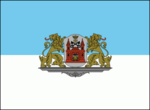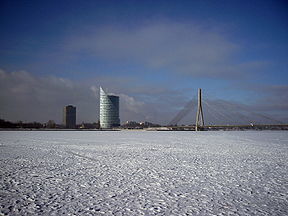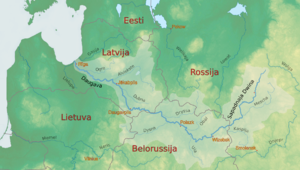- Daugava River
-
Daugava
The Daugava in Riga during winterOrigin Russia Mouth Gulf of Riga, Baltic Sea Basin countries Belarus, Latvia, Russia, Lithuania, Estonia Length 1,022 km (635 mi) Source elevation 221 m (725 ft) Mouth elevation 0 m (0 ft) Avg. discharge 678 m3/s (23,900 cu ft/s) Basin area 87,900 km2 (33,900 sq mi) The River Daugava (in Latvian) or Western Dvina (Russian: Западная Двина́ (Zapadnaya Dvina); Belarusian: Заходняя Дзвіна, [zaˈxodnʲaja dzʲvʲiˈna], traditionally Дзвiна, Dzvina; German: Düna), not to be confused with Northern Dvina, is a river rising in the Valdai Hills, Russia, flowing through Russia, Belarus, and Latvia, draining into the Gulf of Riga in Latvia, an arm of the Baltic Sea. The total length of the river is 1,020 km (630 mi): 325 km in Russian Federation, 328 km in Belarus, and 367 km – in Latvia. In the 19th century, it was connected by a canal to the Berezina and Dnieper rivers (canal is currently not functioning). The Daugava forms part of the international border between Latvia and Belarus.
There are three hydroelectric dams on the Daugava River – Rīgas HES just upstream from Riga or 35 km from the mouth of the river, Ķegums HPP another 35 km further up or 70 km from the mouth, and Pļaviņas HPP another 37 km upstream or 107 km from the mouth. A fourth one, Daugavpils HES, has been planned but has faced strong criticism. Belarus currently plans to build several hydroelectric dams on the Belarusian part of Western Dvina.
Contents
Etymology
The Latvian name for the river, "Daugava" originated from the ancient Baltic words for "the great water" (daudz ūdens). The names for the Daugava in other languages; Dyna – Двина – Дзьвіна – Dźwina -Düna – Dvina; originated from the Finno-Ugric name Vīna-Väinä, for passage-to-the-sea. This name is mentioned in the Viking sagas and the Chronicle of Nestor.
Cities, towns and settlements by the Daugava River
Russia
Andreapol, Zapadnaya Dvina and Velizh.
Belarus
Ruba, Vitsebsk, Beshankovichy, Polatsk with Boris stones strewn in the vicinity, Navapolatsk, Dzisna, Verkhnedvinsk, and Druya.
Latvia
Krāslava, Daugavpils, Līvāni, Jēkabpils, Pļaviņas, Aizkraukle, Jaunjelgava, Lielvārde, Kegums, Ogre, Ikšķile, Salaspils and Riga.
Crossings of the Daugava River
Belarus
Kirov Bridge, Vitebsk.
Latvia
Southern Bridge, Island Bridge, Railway Bridge, Stone Bridge and Shroud Bridge, Riga.
Main tributaries
References
Richard C. Frucht; Aldis Purs. Latvia. ABC-CLIO. pp. 115. http://books.google.com/books?id=lVBB1a0rC70C&pg=PA115&lpg=PA115&dq=daugava+river#v=onepage&q=daugava%20river&f=false. Retrieved 2009-08-01.
External links
Coordinates: 57°3′42″N 24°1′50″E / 57.06167°N 24.03056°E
Riga cityscape Buildings Castle • Cat House • Convent Yard • Daugavgrīva • House of the Blackheads • Large Guild • Latvian Academy of Sciences • National Library of Latvia • Powder Tower • Small Guild • Swedish Gate • Three Brothers
Hotels Grand Palace • Radisson Blu DaugavaMonuments & memorials Brothers' Cemetery • Bikernieki Memorial • Freedom Monument • Great Cemetery • Pokrov Cemetery • Victory Memorial to Soviet ArmyParks & gardens Vērmanes GardenPlaces of worship Structures Tourist attractions Waterways Daugava RiverCategories:- Daugava River
- International rivers of Europe
- Daugava basin
- Rivers of Smolensk Oblast
- Rivers of Tver Oblast
- Rivers of Vitsebsk Voblast
- Rivers of Latvia
- Belarus–Latvia border
Wikimedia Foundation. 2010.





